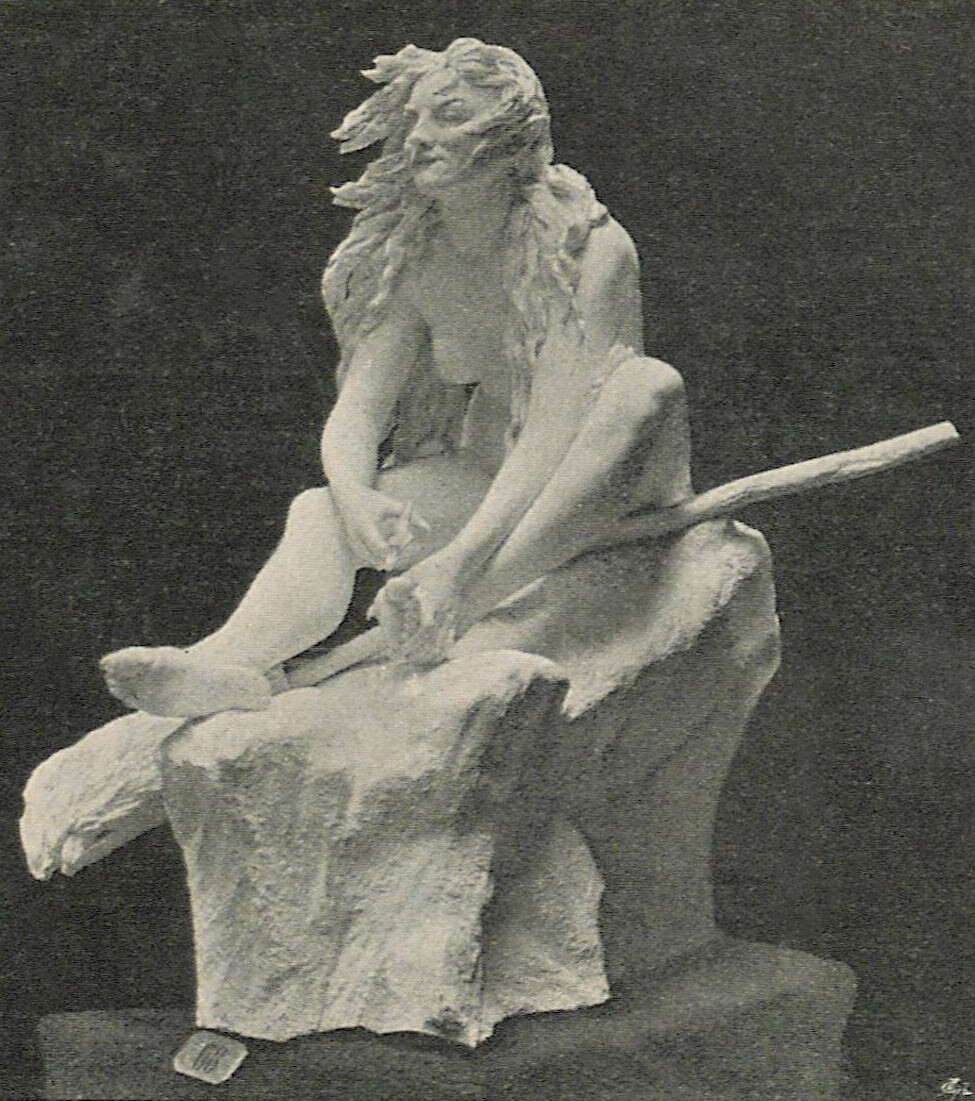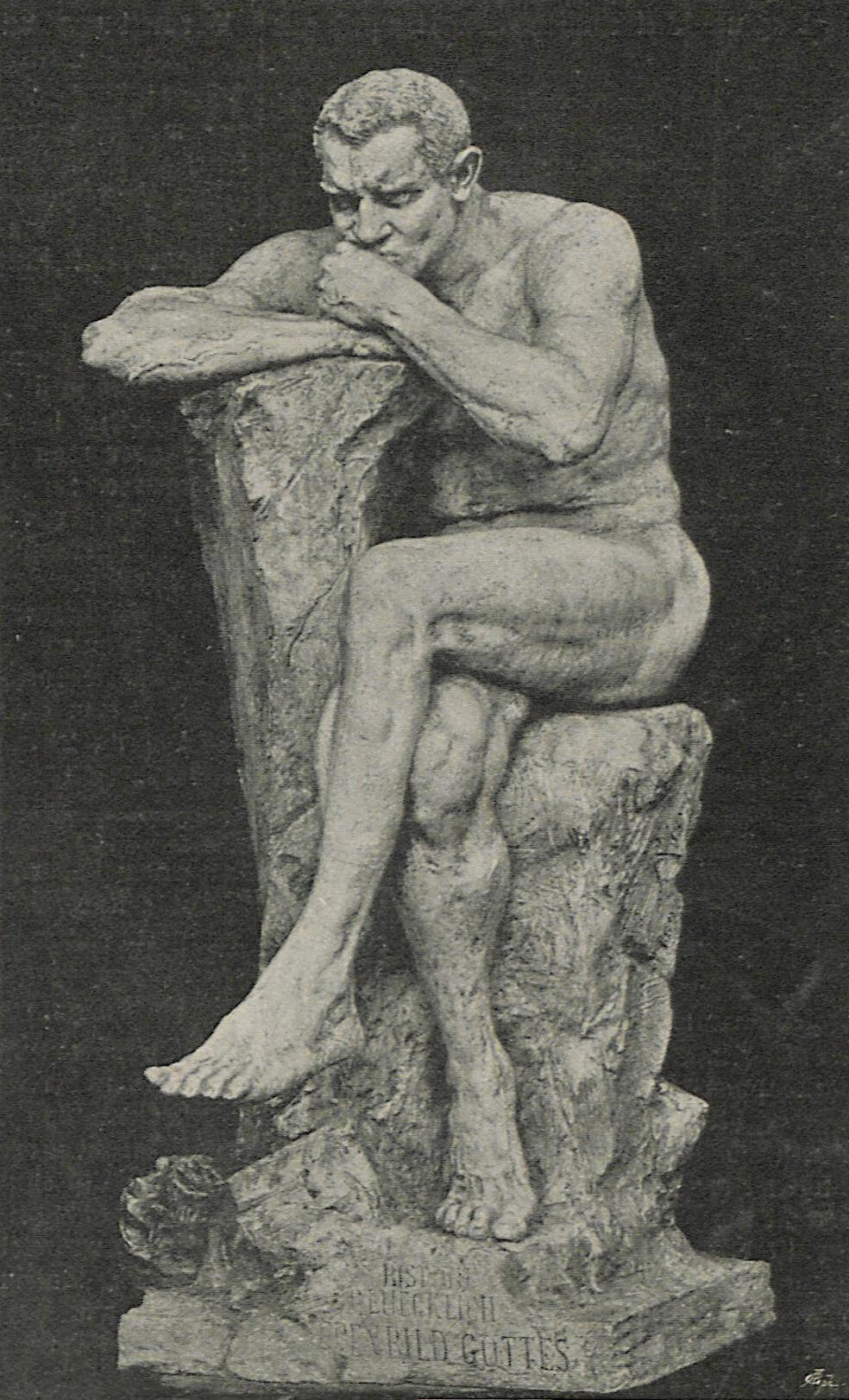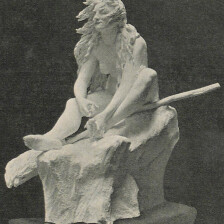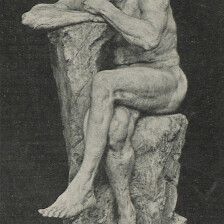Teresa Feodorowna Ries
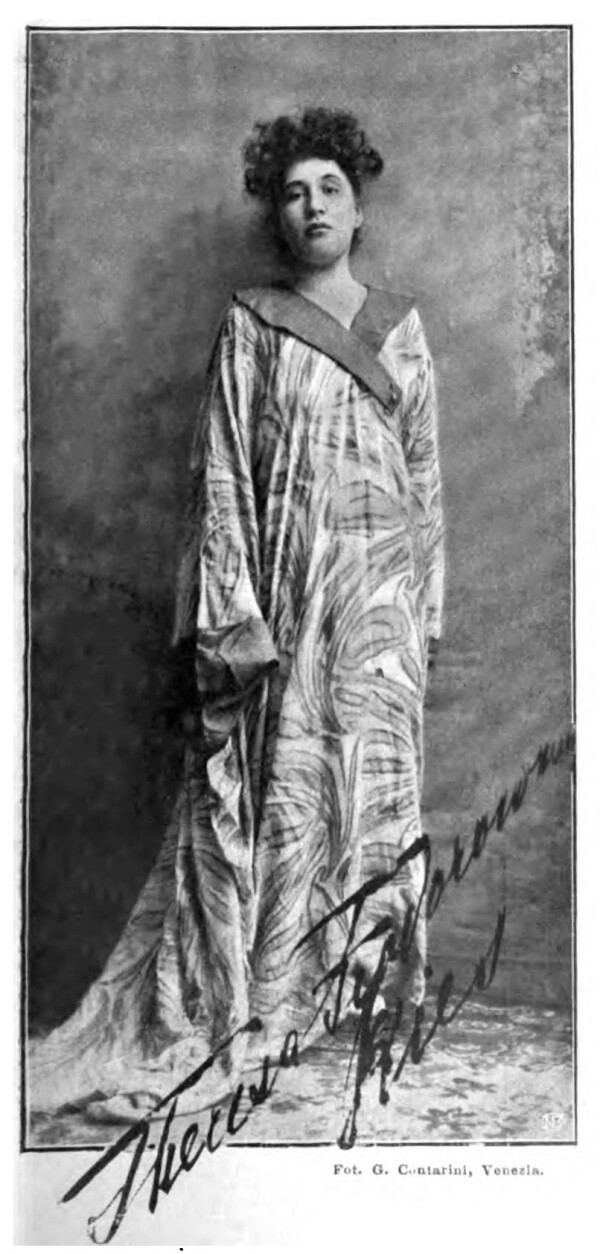
Teresa Feodorowna Ries photographed by G. Contarini around 1906, in: G. Ricordi & C. (Hg.): Ars et Labro. Musica & Musicisti Rivisita Mensile Illustrata, 62. Jg., Nummer 7 (1906).
© Ricordi & C. S.r.l. Milano
Ries made a name for herself as a sculptress and paintress on the male-dominated art scene around 1900. Her artistic oeuvre was much acclaimed by her colleagues as well as the general public. She was one of the first sculptresses to receive a public commission.
Teresa Feodorowna Ries was born in Prague on 30 January 1866 and grew up as the child of a wealthy Jewish family in Moscow. Her father was Gutmann Ries, her mother Bertha Ries, née Stern.
Training as a Sculptress
Ries developed an interest in visual arts at a young age. After attending a boarding school for girls, she studied sculpture and painting at the Moscow Academy of Fine Arts from the age of 16. Unlike other academies in Europe, the Moscow Academy accepted female art students. Her early works already won awards; she was expelled from the academy for disciplinary reasons, however.
In 1894, the Ries family emigrated to Vienna, where Teresa continued her training as a sculptress. As a woman, she was not allowed to study at the Vienna Academy of Fine Arts. Sculpting, in particular, was seen as an occupation that was unsuitable for women. With her statue Sleepwalker (1894, Wien Museum), she was able to convince the Academy professor Edmund Hellmer and Rudolf Wey, a sculptor of the Ringstraße period, to give her private lessons. They recognized the young woman’s talent, supported her and introduced her to the Austrian art scene.
Debut at the Künstlerhaus
Ries was given her first opportunity to present one of her works at an exhibition in 1896. With her sculpture Witch Preparing for Walpurgis Night (Wien Museum, Vienna), the young artist achieved instant fame. The art critic Xaver von Gayrsperg published the following review:
“[...] thus the interesting Russian artist fascinates [...] with the refined absurdity of her work. A bafflingly unkempt and disconcertingly ugly witch is cutting the nails of her toes. The marble sculpture attracts and repulses; it is truly a veritable child of modern intentions.”
Emperor Franz Joseph I was also intrigued by the young artist’s work. Ries was therefore personally introduced to the Emperor at the opening of the exhibition.
In 1897, she won the Karl Ludwig Medal for her sculpture Lucifer (1897, destroyed in World War II) at the “Jahresausstellung des Künstlerhauses” [“Annual Exhibition of the Vienna Künstlerhaus”]; it was the only sculpture with a male subject to be presented at the exhibition that year.
First Artistic Successes
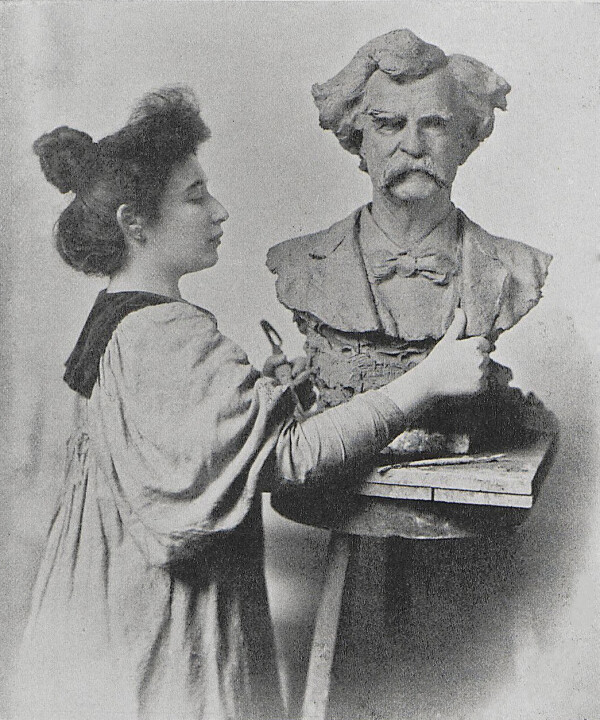
Teresa Feodorowna Ries working on the bust for Mark Twain, around 1898 , in: Studio. International art, Nummer 17 (1899).
© Heidelberg University Library
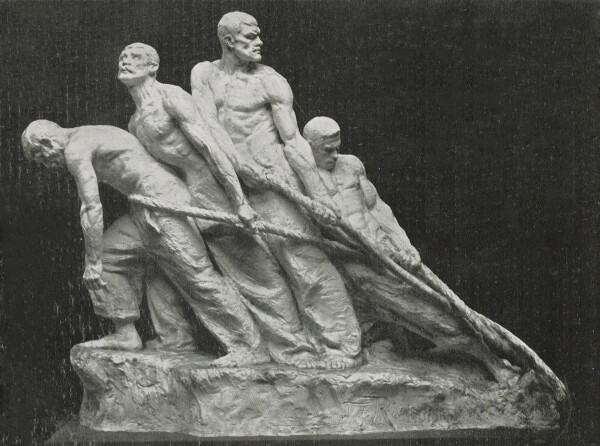
Teresa Feodorowna Ries: The Invincibles, 1900, in: Die Kunst für Alle. Malerei, Plastik, Graphik, Architektur, 19. Jg. (1903/04).
© Heidelberg University Library
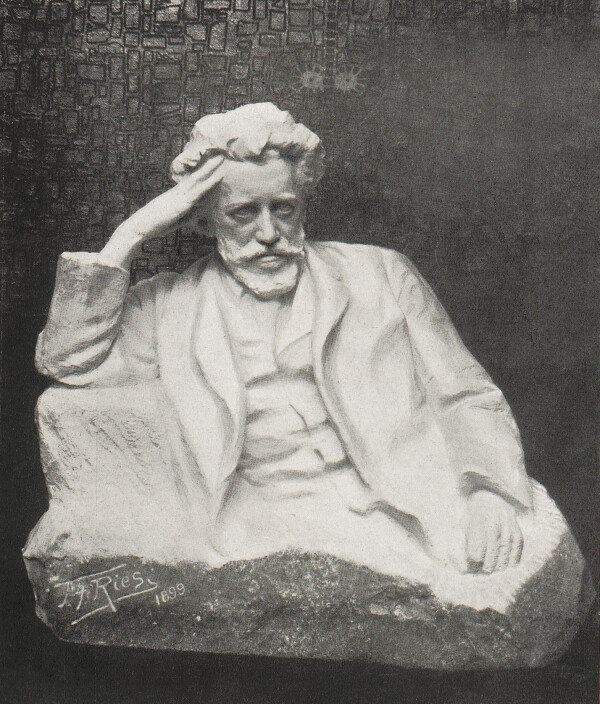
Teresa Feodorowna Ries: Bust of Edmund Hellmer, 1899, in: Deutsche Kunst und Dekoration, Band 5 (1899).
© Heidelberg University Library
Ries and the Secession
These first successes sparked an ever growing interest in the artist on the local art scene. The Secessionists surrounding Gustav Klimt also recognized the potential of the young modern sculptress and invited her to present her works at the “IV. Ausstellung der Vereinigung bildender Künstler Österreichs Secession” [“4th Exhibition of the Association of Austrian Artists Secession”] in 1899. There, her sculptures stood in direct comparison to works by internationally renowned sculptors like Auguste Rodin, Joseph Maria Olbrich, Otto Wagner and Franz Stuck. She presented a total of six works – most of them portrait busts – including a portrait of her teacher Edmund Hellmer, a founding member of the Secession. The critics praised the naturalistic depiction of the subjects:
“[...] the brilliantly executed portrait busts by the sculptress Teresa Feodorowna Ries, whose renown as an artist continues to grow, captivate the audience with their thrilling liveliness.”
Ries went on to portray more and more celebrities. One of her most famous busts is that of the American writer Mark Twain (1898, current location unknown).
Ries was able to build on her first successful exhibition at the Secession in the following year. At the “VII. Ausstellung der Vereinigung bildender Künstler Österreichs Secession” [“7th Exhibition of the Association of Austrian Artists Secession”], her monumental sculpture Invincibles (1900, Kongresspark, Vienna-Ottakring, 16th District) was presented. Since the sculpture could not be completed in time for the opening, it was added later on. Invincibles replaced Gustav Klimt’s Faculty Painting Philosophy (1900–1907, destroyed by fire at Immendorf Castle in 1945), which had to be taken down prematurely to be transported to the Paris World’s Fair (1900). Klimt’s work had caused an enormous scandal and was therefore one of the most significant and most frequently reviewed exhibits. The fact that Ries’s sculpture was deemed suitable to replace this central painting in the exhibition shows the Secession’s great appreciation for the artist’s work. Viennese audiences were also very interested in the sculpture. The work was discussed in great detail in exhibition reviews and was even the sole subject of several articles.
National and International Success
It was probably due to this great success that the sculpture was eventually sent on to the World’s Fair in July, after the closing of the exhibition. The French newspaper La Fronde reported that a new group sculpture called “Les Invincibles,” which was not listed in the catalogue, had been put up at the Grand Palais unexpectedly and in violation of the rules. Ries also presented her portrait bust of Hellmer in the Austrian part of the exposition. The unusual later addition to the World’s Fair was considered justified, however, because of its special artistic value. In France, Ries was awarded with a bronze medal at the World’s Fair and with the honorary title Officier d'académie francais in 1902.
Her international success also opened up new opportunities for the artist in Vienna. Together with seven other women artists, including Marie Egner and Olga Wisinger-Florian, she founded the artists’ association Acht Künstlerinnen in 1901. The group held regular exhibitions at the Pisko Gallery from 1901 to 1909.
Furthermore, her success made Ries one of the first women to receive a public commission. In 1901, the minister of education Wilhelm von Hartel commissioned her to create a sculpture of Saint Barbara for the Marine Church in Pula. She was also commissioned to sculpt a Funerary Monument for an Adolescent (1902), which was to be put up at Vienna’s Central Cemetery. The work was exhibited at the Secession after its completion in 1903.
In addition to classic exhibition activities at the Secession and the Pisko Gallery, Ries also organized more and more tours and celebrations at her studio, initially located at Salmgasse 8. In 1906, her patron, the Prince of Liechtenstein, gave her a new studio in the park of his palace at Liechtensteinstraße 48. There, Ries continued the tradition of her studio exhibitions. In the same year, she held a retrospective of her own work to celebrate ten years of her artistic activity in Vienna.
1911 marked her second successful participation in a World’s Fair, this time in Turin. She had been invited by the delegations of both her home country Russia and her adopted country Austria-Hungary.
World Wars and Exile
During World War I, Ries’s artistic activity decreased considerably. Her private life was upset by the ending of a short marriage and she could no longer rely on aristocratic patrons after the end of the War. Ries tried to compensate for these difficulties by holding more exhibitions and celebrations at her studio. In 1913, she for instance presented a collective exhibition of her works. In 1921 she tried to donate all her works to the Jewish National Museum in Palestine, but the effort failed because of the high costs for exporting the works.
When the City of Vienna purchased her sculpture Invincibles and put it up in Vienna’s Kongresspark in 1928, Ries gave a costume party at her studio. The same year, Ries wrote her autobiography titled Die Sprache des Steines [“The Language of Stone”].
After the “Anschluss,” Austria’s integration into the German Reich in 1938, the studio of the Jewish artist Teresa Ries was seized, including all the artworks it contained. Most of her works were destroyed as “degenerate” art and Ries was banned from exercising her profession. In 1941 she emigrated to Switzerland, where she assumed the name of her first husband, calling herself Loevitowa. After the end of the War, the artist actively tried to regain her works. The sculpture Invincibles, which had been removed during the time of Austrofascism, was again put up in its original location after World War II.
Teresa Feodorowna Ries died in exile in Lugano on 16 July 1956. Even though she had been one of the most successful women artists in Vienna around 1900, her oeuvre was almost entirely forgotten after World War II.
Ries managed to succeed in a professional world dominated by men. She was one of only a few women artists who were able to make a living with their art, independent of their husbands. In a society that negated all forms of female artistic genius, her many awards testified to the opposite. Especially in the field of sculpture, for which women were thought unqualified because of their alleged lack of spatial perception, Ries was able to make a name for herself and achieve international renown.
Literature and sources
- Artblog. www.theartblog.org/2012/06/the-forgotten-women-artists-of-vienna-1900/ (04/23/2020).
- Artblog. www.theartblog.org/2012/06/the-forgotten-women-artists-of-vienna-1900/ (04/23/2020).
- Art in Words. artinwords.de/kuenstlerinnen-in-wien-von-1900-bis-1938-stadt-der-frauen/ (04/23/2020).
- Jüdisches Museum Wien. www.jmw.at/de/blog/eine-hexe (04/23/2020).
- ÖNB. Frauen in Bewegung. fraueninbewegung.onb.ac.at/node/1085 (04/23/2020).
- Wien Geschichte Wiki. Teresa Feodorowna-Ries. www.geschichtewiki.wien.gv.at/Teresa_Feodorowna_Ries (04/23/2020).
- Stella Rollig, Sabine Fellner (Hg.): Stadt der Frauen / City of Women. Künstlerinnen in Wien 1900–1938 / Female Artists in Vienna 1900–1938, Ausst.-Kat., Lower Belvedere (Vienna), 25.01.2019–19.05.2019, Munich - New York - Vienna 2019.
- Anthony Beaumont (Hg.): Alma Mahler-Werfel. Tagebuch-Suiten. 1898–1902, Frankfurt am Main 1997.
- Anka Leśniak: Teresa Feodorowna Ries and The Witch. journal.doc.art.pl/pdf21/art_and_documentation_21_teresa_ries_studies_lesniak.pdf (09/14/2021).
- Bernhard Münz: Theresa Feodorowna Ries, in: Ost und West. Illustrierte Monatsschrift für das gesamte Judentum, 6. Jg., Heft 3 (1906), S. 183-188.
- Stefan Zweig: Das Geheimnis des künstlerischen Schaffens. Gesammelte Essays, Frankfurt am Main 1984, S. 18.
- Julie M. Johnson: The Memory Factory. The Forgotten Women Artists of Vienna 1900, West Lafayette 2012.
- Neuigkeits-Welt-Blatt, 22.03.1896, S. 13.
- Vereinigung bildender Künstler Österreichs Secession (Hg.): Katalog der IIII. Kunstausstellung der Vereinigung Bildender Künstler Österreichs Secession, Ausst.-Kat., Secession (Vienna), 18.03.1899–31.05.1899, Vienna 1899, S. 17.
- Arbeiter-Zeitung, 21.03.1899, S. 4.
- Vereinigung bildender Künstler Österreichs Secession (Hg.): Katalog der VII. Ausstellung der Vereinigung bildender Künstler Österreichs Secession, Ausst.-Kat., Secession (Vienna), 09.03.1900–06.06.1900, 1. Auflage, Vienna 1900.
- Vereinigung bildender Künstler Österreichs Secession (Hg.): Katalog der VII. Ausstellung der Vereinigung bildender Künstler Österreichs Secession, Ausst.-Kat., Secession (Vienna), 09.03.1900–06.06.1900, 2. Auflage, Vienna 1900.
- Deutsches Volksblatt, 04.04.1900, S. 8.
- N. N.: Das neueste Werk der russischen Bildhauerin Theresa Feodorowna Ries in der Wiener Secession. Die Gruppe „Die Unbesiegbaren“, in: Das interessante Blatt, 12.04.1900, S. 8-10.
- La Fronde, 02.07.1900, S. 2.
- Journal des artistes, 23.08.1900, S. 3226.
- Neue Freie Presse, 31.01.1902, S. 7.
- N. N.: Bei Theresa Feodorowna Ries, in: Neue Freie Presse, 03.03.1902, S. 5.
- Wiener Allgemeine Zeitung, 08.04.1913, S. 4.
- N. N.: Zusammenfassende Darstellung betreffend die Widmung von Kunstobjekten aus dem Atelier der Bildhauerin Teresa Feodorowna Ries an die Städtischen Sammlungen, in: Restitutionsbericht 2019. 20. Bericht der Amtsführenden Stadträtin für Kultur und Wissenschaft von Wien über die gemäß dem Gemeinderatsbeschluss vom 29. April 1999 in der Fassung vom 29. April 2011 erfolgte Übereignung von Kunst- und Kulturgegenständen aus den Sammlungen der Museen der Stadt Wien, der Wienbibliothek im Rathaus sowie dem Jüdischen Museum der Stadt Wien, Vienna 2019, S. 111-142.
- Neues Wiener Tagblatt (Tagesausgabe), 22.03.1896, S. 5.


